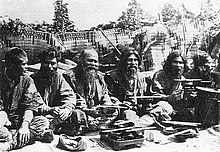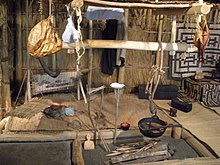আইনু জনগোষ্ঠী
 ১৯০২ সালের ছবি একদল আইনু নৃগোষ্ঠী | |
| উল্লেখযোগ্য জনসংখ্যার অঞ্চল | |
|---|---|
| ২৫,০০০–২০০,০০০ | |
| ১০৯[১]–1000
| |
| ভাষা | |
| ঐতিহাসিক ভাবে আইনু ভাষায় কথা প্রচলিত আছে। অধিকাংশ আইনুজাপানি বা রুশ ভাষায় কথা বলেন.[২] | |
| ধর্ম | |
| অ্যানিমিজম, বৌদ্ধ, রুশ অর্থডোক্স খ্রিষ্টধর্ম | |
| সংশ্লিষ্ট জনগোষ্ঠী | |
| কামচাদাল | |
আইনু জনগোষ্ঠী (আইনু アィヌ Aynu; জাপানিজ: アイヌ Ainu; রুশ: Айны Ajny) জাপানের নৃগোষ্ঠীর মধ্যে অন্যতম এক গোষ্ঠী। জাপানের হোক্কাইদো ও রাশিয়ার শাখালিন ও কুরিল দ্বীপেই তাদের জনগোষ্ঠীর বসবাস। ঐতিহাসিক ভাবে, এই জনগোষ্ঠীর ভাষা আইনু। বর্তমানে খুব কম মানুষ এ ভাষায় কথা বলেন। বর্তমানে মোট কত জন আইনু অধিবাসী আছেন তার হিসেব অপ্রকাশিত। ধারণা করা হয়, আনুষ্ঠানিক নথিপত্র হিসেবে আইনু অধিবাসীদের সংখ্যা ২৫ হাজারের মত। বেসরকারী হিসেবে এই সংখ্যা ২ লাখের কিছু বেশি বলে বিভিন্ন পরিসংখ্যানে দেখা যায়।
ইতিহাস

প্রাক-আধুনিক
সাম্প্রতিক গবেষণায় জানা যায়, আইনু সংস্কৃতিক উদ্ভব হয়েছিল ওখোৎস্ক ও সাৎসুমন সংস্কৃতির সংকরায়নের ফলে।[৪] ১২৬৪ সালে আইনুরা চীনের ইয়ুয়ান সাম্রাজ্যের অধীনস্থ নিভখ জনগোষ্ঠীর ভূখণ্ড আক্রমণ করে বলে জানা যায়।[৫] জাপানি ওয়াজিন নৃগোষ্ঠী ও হোক্কাইদোর বা প্রাচীন ইজোচির আইনুদের মধ্যে সংযোগ হয় ১৩ শতকে।[৬] এসময়েই শিকারী আইনু গোষ্ঠীর উদ্ভব হয়। সে সময় থেকে আইনুদের প্রধান পেশা মৎস্যশিকার আর প্রকৃত নির্ভর ধর্ম গ্রহণের প্রবণতা দেখা যায়।[৭]
মুরোমাচি সময়ে (১৩৩৬–১৫৭৩), জাপানের মূল ভূখণ্ডের অধিবাসী ও আইনুদের মধ্যে সংঘাত পরিস্থিতির ইতিহাস জানা যায়। Takeda Nobuhiro আইনু নেতা কোসামাইনকে হত্যা করেন। ১৪৫৬ সালের জাপানিদের অগ্রাসনে আইনুরা জাপানের শাসনে আসে।
তোকুগা সময়ে (১৬০০–১৮৬৮) আইনুরা হোক্কাইদো শহরে বাণিজ্যে আগ্রগামী ভূমিকা পালন করে।
মাৎসুমে ও শোগুনেট শাসনামলে আইনুদের সংখ্যা হ্রাস পেতে থাকে।[৮] অনেক যুদ্ধে আইনুরা পরাজিত হয়ে দাস হিসেবে অধিগ্রহণের শিকার হয়।[৯]
মেইজি পুনরূদ্ধার ও পরবর্তী ইতিহাস
১৮৬৮ সালে হোক্কাইদোতে ১৫ হাজার, সাখালিনের ২ হাজার ও কুড়িল দ্বীপে ১০০ জন আইনু অধিবাসী বাস করতেন।[১০] ১৮৭৩ সালে এই সংখ্যা ১৬ হাজারে এসে দাড়ায়। [১১] আইনুরা অন্য গোষ্ঠীর সদস্যদের বিয়ের কারণে তাদের সংখ্যা কমতে থাকে।[১২]
১৮৬৯ সালে নতুন মেইজি সরকার ক্ষমতায় এসে হোক্বাইদোর নামকরণ করে এজো। এসময় আইনু ভাষাকে নিষিদ্ধ ঘোষণা করা হয়। [তথ্যসূত্র প্রয়োজন] ১৮৯৯ সালে জাপানি সরকার মেইজিদের আদিবাসী হিসেবে ঘোষণা দেয়।[১৩]

নামকরণ
আইনু শব্দের অর্থ মানুষ, যা কামুই শব্দ থেকে উদ্ভুদ্ধ।
জাপানে আনুষ্ঠানিক পরিচয়

২০০৮ সালের ৬ জুন জাপানের ডায়েটে আইনুদের আনুষ্ঠানিক ভাবে আদিবাসী হিসেবে ঘোষণা করে।"[১৪]
উৎপত্তি

আইনুরা বিশ্বাস করে তারা জাপানের জোমন গোষ্ঠী থেকে আগত সম্প্রদায়।[১৫] আইনুদের বিশ্বাস অনুসারে তারা সূর্যের সন্তানের বংশধর।[১৬] সাম্প্রতিক গবেষণায় জানা যায়, আইনুরা অখোৎস্ক সংস্কৃতির অংশ ছিল।[১৭][১৮]
ভাষা
সাম্প্রতিক হিসেবে মাত্র ১০০ জন মানুষ আইনু ভাষায় কথা বলেন।[১৯] বিভিন্ন গবেষণায় এই সংখ্যা ১৫ জন বলে প্রকাশ করা হয়।[২০]
ধর্ম

আইনুরা ঐতিহাসিকভাবে অ্যানিমিস্ট।
আবাসন



আইনুদের ভাষায় গ্রামকে কোটান বলা হয়। আর তারা বাড়িকে সিজে বলে।
আরও দেখুন
টেমপ্লেট:Organize section
- Ainu in Russia
- Ainu-ken
- Akira Ifukube
- Bibliography of the Ainu
- Bronisław Piłsudski
- Constitution of Japan
- Declaration on the Rights of Indigenous Peoples
- Emishi
- Aterui
- Ethnocide
- Hiram M. Hiller, Jr.
- Indigenous peoples
- Shigeru Kayano
- Nibutani Dam
সূত্র
- Levin, Mark A. (২০০১)। "Essential Commodities and Racial Justice: Using Constitutional Protection of Japan's Indigenous Ainu People to Inform Understandings of the United States and Japan"। New York University Journal of International Law and Politics। 33: 419, 447। সংগ্রহের তারিখ মে ১১, ২০১৫।
তথ্যসূত্র ও বিস্তারিত গবেষণা
চিসাম, হিউ, সম্পাদক (১৯১১)। "Ainu"। ব্রিটিশ বিশ্বকোষ (১১তম সংস্করণ)। কেমব্রিজ ইউনিভার্সিটি প্রেস।
- Batchelor, John (১৯০১)। "On the Ainu Term `Kamui"। The Ainu and Their Folklore। London: Religious Tract Society।
- Etter, Carl (২০০৪) [1949]। Ainu Folklore: Traditions and Culture of the Vanishing Aborigines of Japan। Whitfish, MT: Kessinger Publishing। আইএসবিএন 1-4179-7697-7।
- Fitzhugh, William W.; Dubreuil, Chisato O. (১৯৯৯)। Ainu: Spirit of a Northern People। Seattle: University of Washington Press। আইএসবিএন 0-295-97912-7। ওসিএলসি 42801973।
- Honda Katsuichi (১৯৯৩)। Ainu Minzoku (Japanese ভাষায়)। Tokyo: Asahi Shimbun Publishing। আইএসবিএন 4-02-256577-2। ওসিএলসি 29601145।
- Ichiro Hori (১৯৬৮)। Folk Religion in Japan: Continuity and Change। Haskell lectures on History of religions। 1। Chicago: University of Chicago Press।
- Junko Habu (২০০৪)। Ancient Jomon of Japan। Cambridge: Cambridge University Press। আইএসবিএন 0-521-77670-8। ওসিএলসি 53131386।
- Hitchingham, Masako Yoshida (trans.),Act for the Promotion of Ainu Culture & Dissemination of Knowledge Regarding Ainu Traditions[অকার্যকর সংযোগ], Asian-Pacific Law & Policy Journal, vol. 1, no. 1 (2000).
- Kayano, Shigeru (1994). Our Land Was A Forest: An Ainu Memoir. Westview Press. আইএসবিএন ০-৮১৩৩-১৮৮০-৭. আইএসবিএন ৯৭৮-০-৮১৩৩-১৮৮০-৬.
- Landor, A. Henry Savage (১৮৯৩)। Alone with the Hairy Ainu. Or, 3,800 miles on a Pack Saddle in Yezo and a Cruise to the Kurile Islands। London: John Murray।
- Levin, Mark, Essential Commodities and Racial Justice: Using Constitutional Protection of Japan’s Indigenous Ainu People to Inform Understandings of the United States and Japan (2001). New York University of International Law and Politics, Vol. 33, p, 419, 2001 . Available at SSRN: http://ssrn.com/abstract=1635451
- Levin, Mark (trans.), Kayano et al. v. Hokkaido Expropriation Committee: ‘The Nibutani Dam Decision’ (1999). International Legal Materials, Vol. 38, p. 394, 1999. Available at SSRN: http://ssrn.com/abstract=1635447
- Siddle, Richard (১৯৯৬)। Race, Resistance and the Ainu of Japan। London: Routledge। আইএসবিএন 0-415-13228-2। ওসিএলসি 243850790 33947034
|oclc=এর মান পরীক্ষা করুন (সাহায্য)। - Starr, Frederick (১৯০৫)। "The Hairy Ainu of Japan"। Proceedings of the Second Yearly Meeting of the Iowa Anthropological Association। Iowa City: State Historical Society of Iowa।
- Walker, Brett (২০০১)। The Conquest of Ainu Lands: Ecology and Culture in Japanese Expansion, 1590–1800। Berkeley: University of California Press। আইএসবিএন 0-520-22736-0। ওসিএলসি 45958211 59471355 70749620
|oclc=এর মান পরীক্ষা করুন (সাহায্য)। - Article on the Ainu in Japan's Minorities: The Illusion of Homogeneity.
- John Batchelor (১৯০১)। The Ainu and their folk-lore। London: Religious Tract Society। পৃষ্ঠা 603। সংগ্রহের তারিখ মার্চ ১, ২০১২।(Harvard University)(Digitized Jan 24, 2006)
- John Batchelor (১৮৯২)। The Ainu of Japan: the religion, superstitions, and general history of the hairy aborigines of Japan। London: Religious Tract Society। পৃষ্ঠা 336। সংগ্রহের তারিখ মার্চ ১, ২০১২।
- Basil Hall Chamberlain (সম্পাদক)। Aino Folk-Tales। Forgotten Books। সংগ্রহের তারিখ মার্চ ১, ২০১২।
1606200879
- Basil Hall Chamberlain (১৮৮৮)। Aino folk-tales: By Basil Hall Chamberlain. With introduction by Edward B. Taylor। Volume 22 of Publications of the Folklore Society। Privately Printed for THE FOLK-LORE SOCIETY 1888 XXII. Reprinted in Saxony from the original edition by C. G. Röder, Ltd., Leipsic: Privately printed for the Folk-lore Society। পৃষ্ঠা 57। সংগ্রহের তারিখ মার্চ ১, ২০১২।(Indiana University)(Digitized Sep 3, 2009)
- Batchelor, John; Miyabe, Kingo (১৮৯৮)। Ainu economic plants। Volume 21। পৃষ্ঠা 43। সংগ্রহের তারিখ ২৩ এপ্রিল ২০১২।[Original from Harvard University Digitized Jan 30, 2008][YOKOHAMA : R. MEIKLEJOHN & CO., NO 49.]
বহিঃসংযোগ
- Rare Japanese Video Featuring Ainu. YWCA c. 1919 ওয়েব্যাক মেশিনে আর্কাইভকৃত ২৭ অক্টোবর ২০১৫ তারিখে
- The Ainu: The First Peoples of Japan. Old videos and photographs arranged by Rawn Joseph
- "The Despised Ainu People." The Ainus' Tense Relationship with Japan. 1994. Journeyman.tv
- The Ainu Museum at Shiraoi
- Smithsonian Institution
- Hokkaido Utari Kyokai
- Sapporo Pirka Kotan Ainu Cultural Center ওয়েব্যাক মেশিনে আর্কাইভকৃত ১৪ জুন ২০২১ তারিখে
- Institute for the Study of Languages and Cultures of Ainu in Samani, Hokkaido
- Ainu-North American cultural similarities
- Foundation for Research and Promotion of Ainu Culture (centers located in Sapporo and Tokyo)
- Hokkaido University Center for Ainu and Indigenous Studies ওয়েব্যাক মেশিনে আর্কাইভকৃত ১ সেপ্টেম্বর ২০১৭ তারিখে
- Ainu Lineage
- The Boone Collection
- Nibutani Ainu Cultural Museum (in Japanese)
- Ainu Komonjo (18th & 19th century records) – Ohnuki Collection
- Article in The Christian Science Monitor, June 9, 2008
- Aino Folk-Tales, Chamberlain, B. H. Folk-Lore Society, 1888. (Members edition, without expurgation)
তথ্যসূত্র
- ↑ ক খ Russian Census 2010 ওয়েব্যাক মেশিনে আর্কাইভকৃত ৯ ডিসেম্বর ২০২১ তারিখে:_ Population by ethnicity ওয়েব্যাক মেশিনে আর্কাইভকৃত ৪ ডিসেম্বর ২০১৩ তারিখে (রুশ)
- ↑ Gordon, Raymond G., Jr. (ed.) (২০০৫)। Ethnologue: Languages of the World (15th সংস্করণ)। Dallas: SIL International। আইএসবিএন 1-55671-159-X। ওসিএলসি 224749653।. ওসিএলসি 60338097.
- ↑ "সংরক্ষণাগারভুক্ত অনুলিপি"। ৫ ফেব্রুয়ারি ২০১৭ তারিখে মূল থেকে আর্কাইভ করা। সংগ্রহের তারিখ ৩১ অক্টোবর ২০১৫।
- ↑ Sato, Takehiro; ও অন্যান্য (২০০৭)। "Origins and genetic features of the Okhotsk people, revealed by ancient mitochondrial DNA analysis"। Journal of Human Genetics। 52 (7): 618–627। ডিওআই:10.1007/s10038-007-0164-z। পিএমআইডি 17568987।
- ↑ "সংরক্ষণাগারভুক্ত অনুলিপি" 第59回 交易の民アイヌ Ⅶ 元との戦い (Japanese ভাষায়)। Asahikawa City। জুন ২, ২০১০। ২১ জুলাই ২০১১ তারিখে মূল থেকে আর্কাইভ করা। সংগ্রহের তারিখ মার্চ ২, ২০১১।
- ↑ Weiner, M. (eds) 1997, Japan’s Minorities: The Illusion of Homogeneity, Routledge, London.
- ↑ "NOVA Online – Island of the Spirits – Origins of the Ainu". Retrieved on May 8, 2008.
- ↑ Conquest of Ainu Lands: Ecology and Culture in Japanese Expansion, 1590-1800 By Brett L. Walker [১]
- ↑ Postmodernism and Race edited by Eric Mark Kramer [২]
- ↑ David Howell. "The Meiji State and the Logic of Ainu 'Protection'", In New Directions in the Study of Meiji Japan, edited by Helen Hardacre, 1997. p. 614.
- ↑ Meeting the First Inhabitants "Encyclopedia of genocide and crimes against humanity"। google.co.uk।
- ↑ [৩][স্থায়ীভাবে অকার্যকর সংযোগ]
- ↑ Loos, N. & Osani, T. 1993, Indigenous Minorities and Education, Sanyusha Publishing Co., Ltd., Tokyo.
- ↑ Ito, M (জুন ৭, ২০০৮)। "Diet officially declares Ainu indigenous"। The Japan Times। সংগ্রহের তারিখ এপ্রিল ২৫, ২০১৫।
- ↑ Denoon, Donald; Hudson, Mark (২০০১)। Multicultural Japan: palaeolithic to postmodern। Cambridge University Press। পৃষ্ঠা 22–23। আইএসবিএন 0-521-00362-8।
- ↑ Sjöberg, Katarina V. (১৯৯৩)। The Return of the Ainu: Cultural Mobilization and the Practice of Ethnicity in Japan। Studies in Anthropology and History। 9। Chur: Harwood Academic Publ.। আইএসবিএন 3-7186-5401-6। ওসিএলসি 27684176।
- ↑ Sato, Takehiro; ও অন্যান্য (২০০৭)। "Origins and genetic features of the Okhotsk people, revealed by ancient mitochondrial DNA analysis"। Journal of Human Genetics। 52 (7): 618–627। ডিওআই:10.1007/s10038-007-0164-z। পিএমআইডি 17568987।
- ↑ Lee, S; Hasegawa, T (২০১৩)। "Evolution of the Ainu Language in Space and Time"। PLoS ONE। 8 (4): e62243। ডিওআই:10.1371/journal.pone.0062243।
- ↑ Hohmann, S. 2008, "The Ainu's modern struggle" in World Watch, Vol 21., No. 6, pp. 20–24.
- ↑ Vovin, A. 1993, A Reconstruction of Proto-Ainu, Brill, p. 3